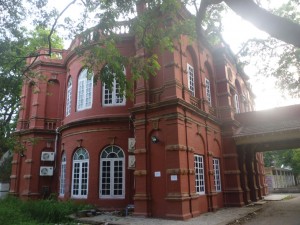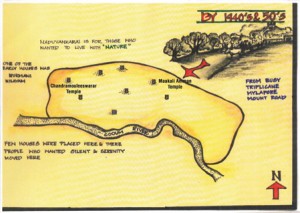Registered with the Registrar of Newspapers for India under R.N.I 53640/91
Vol. XXVI No. 09, August 16-31, 2016
Our Readers write
Was this the College’s home?
This is an exchange that your Editor recently had with Rear Admiral Mohan Raman (Rtd.) who is at present Secretary of the Madras Literary Society (MLS) and is in change of its Library and programmes.

Dear Editor,
So much we value today originated in the scholarly works initiated by F.W. Ellis at the College of Fort St George. All that was done in just 30 years, as the establishment was closed in the 1840s.
Sadly, its site is not too well known. It does not find a place even in the ASI’s Chennai list, which goes back to Stone Age sites. Sriram V once told me that the old building in the DPI compound near the MLS was the College.
Is that true? I ask because the building looks like the MLS in age, and we go back just to 1905.
– Mohan Raman
Dear Admiral,
There used to be a large old red building in the campus in which CARE had its office. If I remember right, it was at the back of the DPI office blocks. It was believed that this was the main building of the College of Fort St. George.
I don’t know whether the building still survives.
– The Editor
Dear Editor,
The building exists, and was handsomely restored and renovated a few years ago; I think Microsoft helped out. It presently houses the computer cell of Samacheer Kalvi.
Sriram V includes it in his regular heritage walks around the DPI compound. He tells me that the original building was probably pulled down in the 19th Century and this one constructed on the cleared site.
I think he would be right. Apart from being the view of a committed researcher like Sriram, the building looks newer architecturally than 1812. In fact, many bits of ornamentation are identical to the MLS building, which dates from 1905.
Further, since the College closed in 1842, it is reasonable to infer that apathy and neglect would have set in. Bharat Insurance and the River Gate in the DPI Compound are examples. Perhaps euthanasia for buildings, as a prescribed remedy, has precedents dating from the Raj!
Mohan Raman
 In the last fortnight’s article from ‘Naduvakkarai to Anna Nagar’ the
In the last fortnight’s article from ‘Naduvakkarai to Anna Nagar’ themap showing the shrines left out the names of the two most important and
ancient temples. We correct the omission in this map.
Keezhadi
The Keezhadi archaeological remains (MM, July 16) are undoubtedly of “magnificent” origin. But how far a sustainable reconstruction of the history of these remains is possible, is yet to be seen. The more antiquated Aditanallur discovery (1866) and its place in the history of Tamil Nadu still remain elusive. There is no updated data whatsoever available on the Aditanallur excavations.
Romila Thapar (2002) once indicated the intrusion of foreign elements in the evolution of this culture. Nearly 170 clay urns containing genetically different human skeletons were unearthed from this site in 2006. Probable considerations at the time, probably brought about a reburial of this evidence. Some potsherds stumbled upon in the vicinity of Aditanallur in recent times seem to bear striking resemblances to some motifs found on earthen jars (of about 3000 BC) recovered from Egyptian sites. But such finds are yet to be suitably pursued.
If we are only looking for monolingual Tamil cultural ethnicity or hegemony in sites such as at Keezhadi or Aditanallur and at such earlier times, we certainly will have to re-learn the vicissitudes of history. I happen to be an ardent student of Tamil Sangam text, but I do not consider their contents to be dovetailed all the time to the so-called archaeological time-frame or vice versa.
Whether it is the Indus Valley heritage or the glory of the Sangam Age or the antiquity of Keezhadi, a lot more homework needs to be done. How ancient is the name Keezhadi is not known. Was this site known by any other name has also to be investigated. Sangam-time references apparently do not seem to indicate any knowledge about the place.
Hence, premeditated dates between the Indus Valley and Sangam times cannot be so casually posited for these finds, as suggested in your report.
Rev. Philip K.Mulley
Anaihatti Road
Kotagiri 643 217
Lost at temple
I felt that I was not alone after reading MMM’s article on visiting the temple to the God of skulls, not finding the chappal booth, left my expensive sandals near one of the entrances to the temple. When I came back from the shrine, found all the footwear scattered, some even beyond the fence around the temple tank. But my diabetic-foot friendly sandals, which I had acquired just a few weeks ago, had disappeared. After walking for a while with my arthritic knees acting up and not finding any footwear shop nearby, I had to take an auto home. I vowed never to go to that temple again.
R. Usha
abayamba@gmail.com

